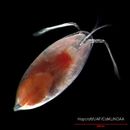Biology
provided by Arctic Ocean Biodiversity 2011
The most common pelagic ostracod of the deep Arctic basins and the outflows of polar water into the Atlantic
- license
- cc-by-nc
- copyright
- Arctic Ocean Diversity
Comprehensive Description
provided by Arctic Ocean Biodiversity 2011
Translucent, tinted with red and yellow; Eggs appear orange through white; Guts are often dark red
- license
- cc-by-nc
- copyright
- Arctic Ocean Diversity
Life Cycle
provided by Arctic Ocean Biodiversity 2011
Female stores sperm and spawns repeatedly; Eggs are scattered into the water; Six juvenile stages before maturity; Generation times are unknown, probably many months; Spawning likely occurs year-round, but peaks in summer
- license
- cc-by-nc
- copyright
- Arctic Ocean Diversity
Trophic Strategy
provided by Arctic Ocean Biodiversity 2011
Particle feeder; Detritivore
- license
- cc-by-nc
- copyright
- Arctic Ocean Diversity
Habitat
provided by Arctic Ocean Biodiversity 2011
Panarctic in deeper waters; Mesopelagic, most abundant between depths of 200-500m
- license
- cc-by-nc
- copyright
- Arctic Ocean Diversity
Boroecia maxima
(
Dutch; Flemish
)
provided by wikipedia NL
Boroecia maxima is een mosselkreeftjessoort uit de familie van de Halocyprididae.[1] De wetenschappelijke naam van de soort is voor het eerst geldig gepubliceerd in 1896 door Brady & Norman.
Bronnen, noten en/of referenties Geplaatst op:
17-03-2013
Dit artikel is een beginnetje over biologie. U wordt uitgenodigd om op bewerken te klikken om uw kennis aan dit artikel toe te voegen.

- license
- cc-by-sa-3.0
- copyright
- Wikipedia-auteurs en -editors

